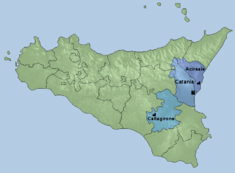Roman Catholic Archdiocese of Catania
| Archdiocese of Catania Archidioecesis Catanensis | |
|---|---|
|
Cathedral in Catania | |
| Location | |
| Country | Italy |
| Ecclesiastical province | Catania |
| Coordinates | 37°30′10″N 15°05′19″E / 37.502809°N 15.088604°E |
| Statistics | |
| Area | 1,332 km2 (514 sq mi) |
| Population - Total - Catholics |
(as of 2006) 734,218 724,886 (98.7%) |
| Parishes | 155 |
| Information | |
| Denomination | Catholic Church |
| Rite | Roman Rite |
| Established | 1st Century |
| Cathedral | Basilica Cattedrale di S. Agata |
| Current leadership | |
| Pope | Francis |
| Archbishop | Salvatore Gristina |
| Emeritus Bishops | Luigi Bommarito |
| Map | |
 | |
| Website | |
| www.diocesi.catania.it | |

The archdiocese of Catania (Latin: Archidioecesis Catanensis) is a Roman Catholic ecclesiastic territory in Sicily, southern Italy, with its seat in Catania. It was elevated to an archdiocese in 1859, and became a metropolitan see in 2000. Its suffragans are the diocese of Acireale and the diocese of Caltagirone.[1]
History
According to legend, Christianity was first preached in Catania by St. Beryllus. During the persecution of Decius the virgin St. Agatha suffered martyrdom. At the same period or a little later the Bishop of Catania was St. Everus, mentioned in the acts of the martyrs of Leontini (303). This same year is marked by the martyrdom of the Deacon Euplius and others.
Domninus, Bishop of Catania was present at the Council of Ephesus (431); another bishop, Fortunatus, was twice sent with Ennodius by Pope Hormisdas to Emperor Anastasius I to effect the union of the Eastern Churches with Rome (514, 516). Bishops Leo and Junius appear in the correspondence of Gregory the Great. In 730 Bishop Jacobus suffered martyrdom for his defence of images. Another bishop, St. Leo II, was known as a wonder-worker (thaumaturgus).
Bishop Euthymius was at first an adherent of Photius, but in the Eighth General Council approved the restoration of Ignatius as patriarch. John of Ajello, who died in the 1169 Sicily earthquake, won a contested episcopal election against William of Blois in 1167. After Ansgar (breton) O.S.B. † (9 marzo 1092 - 1124).Giuliano della Rovere, later Pope Julius II, was also a bishop.
In the 9th century, while still a Greek city, Catania became suffragan to the archdiocese of Monreale. In 1860 it was made an archiepiscopal see, immediately subject to the Holy See.[2]
From 1679 to 1818, the bishop of Catania was the Great Chancellor of the University of Catania.
Suffragan sees
Notes
![]() This article incorporates text from a publication now in the public domain: Herbermann, Charles, ed. (1913). Catholic Encyclopedia. New York: Robert Appleton.
This article incorporates text from a publication now in the public domain: Herbermann, Charles, ed. (1913). Catholic Encyclopedia. New York: Robert Appleton.
| ||||||